WORLD CLASS COACHING
Spanish Style Possession Soccer Vol 2
By Philip Cauchi
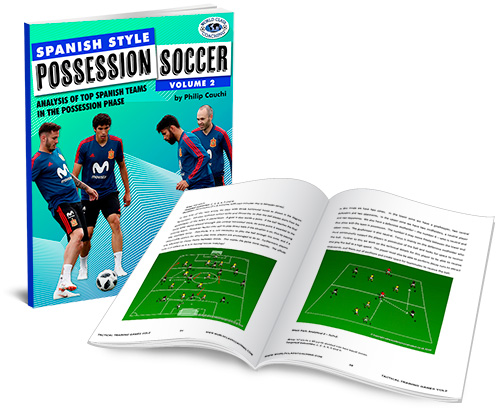
Table of Contents
PART FOUR
Training Sessions
Conclusion
Training Sessions
Session 5
Aim: To switch the point of attack when vertical play is not possible.
Outcomes:
1. Overload ball zone.
2. Staggered angles of support near the ball.
3. Safety option behind the line of the ball.
4. Opposite full back gets wide and ready to receive the ball to attack from the opponents’ weak side.
5. Preventive marking at the back.
6. Movement to receive the ball behind the defence.
Total duration of session: Approximately 90 minutes.
Formation based on: 1-4-3-3.
Complexity level: Team tactics – collective.
Equipment:
Bibs: Ten yellows and six reds.
Balls: At least eight to allow for a better session flow.
Cones: Six
Markers: Twenty to mark pitch.
Description: The aim of this session is to overload the area around the ball thus creating more playing options while at the same time attracting more opponents towards one flank (ball zone) while freeing the opposite. If we are able to play the ball quickly into the opponents’ weak zones, we have a high probability of getting around their defence. This requires a high level of cooperation and collective effort from the whole team to quickly support and overload the other flank once the ball is played into this zone.
Warming Up – 4v4+3 switch zone rondo.
Area: 15 yards x 30 yards divided into two equal zones.
Targeted outcomes: 1, 2 and 3.
Duration: 20 minutes.
We start the warm-up with short passing between players while on the move. We increase the tempo of the warm-up by introducing more balls and require the players to perform a short run of a higher intensity after passing the ball. The passing exercises are interspersed with mobility exercises and dynamic stretching.
After assuring that the players’ neuro-muscular system is engaged, we move on to the below described rondo. Players play 4v4 plus two neutrals who play with the team in possession. After making a pre-set number of consecutive passes, the ball is played to the adjacent zone where the same rondo takes place. The team who had possession of the ball retains it. Rotate the neutral players every three minutes. The goalkeepers also take part in this warm-up as in the main session as is also the case in a match they are required to play under pressure using their feet.
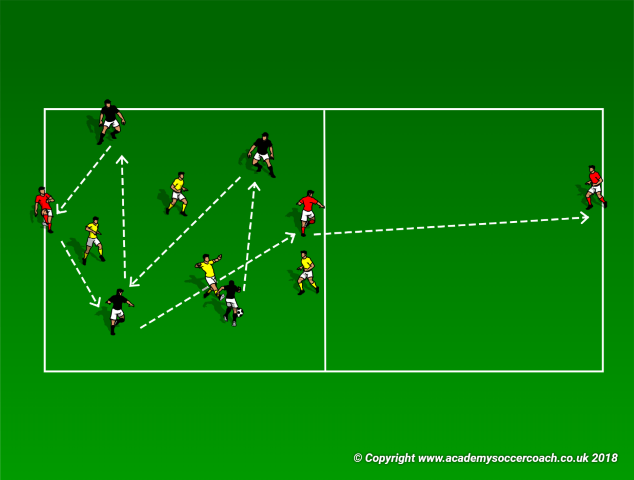
Main Part: Global Situation 1 – 11v11 line soccer.
Area: 45 yards x 50 yards.
Targeted outcomes: 1, 2, 3, 4, 5 and 6.
Duration: 10 minutes (2 x 4 minutes with two minutes rest in between series).
We play on a short and wide pitch with the intention of switching play quickly to the opposition’s weak side whenever direct penetration is not possible. The aim of both teams is to pass or dribble the ball and stop it over the opposition’s line. The goalkeepers take part in this game as during a match they will be asked many times to support the team to retain possession and to also switch the point of attack. As the pitch is short and wide the team in possession is forced to make use of the width and circulate the ball rapidly so to open up gaps in the opposition’s defence. Players are instructed to provide length (forwards 7, 9 and 11), depth (central defenders 4 and 5), and width (full backs 2 and 3). The midfield trio (6, 8 and 10) must continuously move to create angles and passing options for quicker and more precise ball circulation.
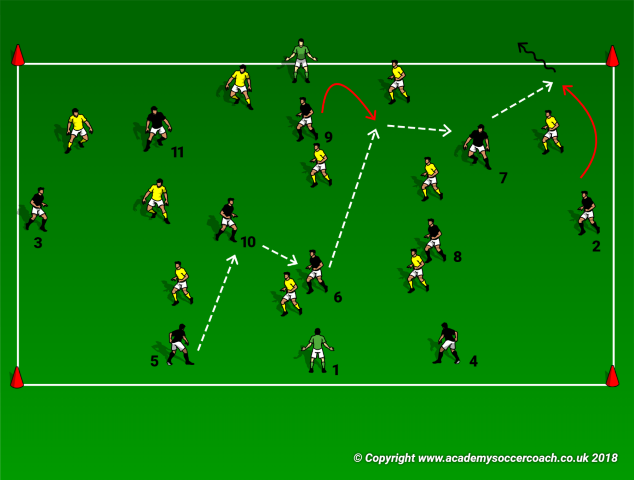
Main Part: Analytical 1 – Possession vs transition.
Area: 45 by 50 yards.
Targeted outcomes: 1, 2, 3, 4, 5 and 6.
Duration: 10 minutes (2 x 5 minutes with two minutes rest between series).
The black team which is the team we are concentrated on, aims to keep possession of the ball. Full backs 2 and 3 remain wide inside their assigned flank zones. They are instructed to remain inside these zones so that width in attack is provided and the team has more space where to circulate the ball. The black team plays against six yellow players (defenders). They score a point by making ten consecutive passes and stopping the ball behind the yellow team’s goal line. Should the yellow players win the ball, they pass it to any of the outside yellow players marked with a circle to score a point. This forces the black team to immediately press upon losing possession of the ball. The four outside yellow players may move between cones to receive the ball. They are changed with other four yellow players from the inside after five minutes. The goalkeepers also take part. The goalkeeper at the bottom of the diagram plays with the black team while the other plays with the yellow team.
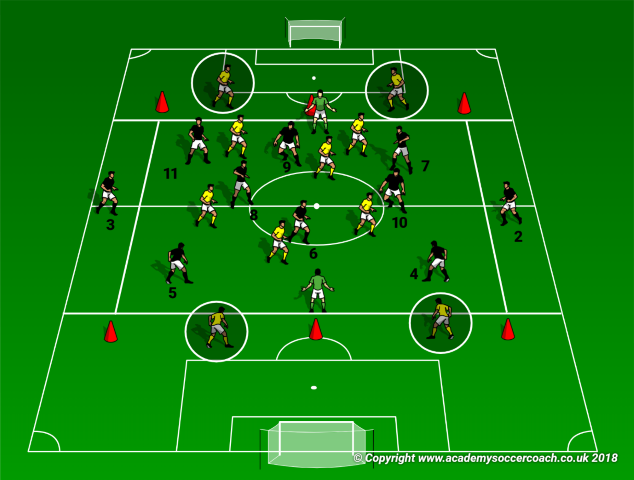
Main Part: Global Situation 2 – 11v11 line soccer.
Area: 45 yards x 55 yards within a regular soccer pitch.
Targeted outcomes: 1, 2, 3, 4, 5 and 6.
Duration: 10 minutes (2 x 4 minutes with two minutes rest in between series).
We play the same as in the global 1 but now the team in attack aims to score by playing the ball behind the line of restraint of the opposite team. No player is allowed except the goalkeeper to remain beyond this line. However, when a team is in possession they try to play the ball behind this line for another player to run onto. When this happens players are allowed to enter this zone and the team in attack aims to score while the defending team defend their goal. When the ball goes out of play, the team in possession restarts the game from the middle horizontal zone. Although it seems easy to play behind the line of restraint, in reality it is not. There are twenty players within a space measuring 45 by 55 yards. The player on the ball must have good positional awareness and be able to play quickly and with accuracy, otherwise he will be easily dispossessed of the ball. At a team level, good strategic positions and use of space is a pre-requisite.
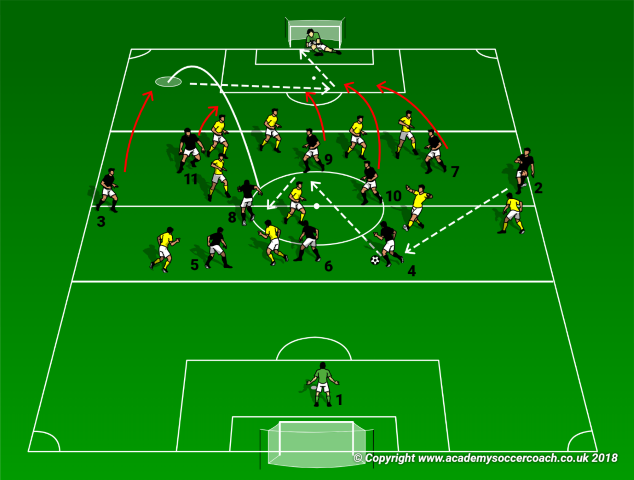
Main Part: Analytical 2 – Switch with rapidity and attack.
Area: 45 yards x 50 yards inside a whole soccer pitch.
Targeted outcomes: 1, 2, 3, 4, 5 and 6.
Duration: 10 minutes (2 x 4 minutes with two minutes rest between series).
The attacking team (blacks) have thirty seconds at their disposal to score playing against seven defenders (yellows) and acquire two points. Full backs 2 and 3 are to remain wide inside their assigned flank zones. They could however move towards the inside while the inside forwards 7 and/or 11 remain wide. If the thirty seconds are over, the yellow players waiting outside the area come into play. From this moment if the black team scores a goal equals one point. If during the first thirty seconds of play the yellow team wins the ball, they counter on the opposite goal. However, the three players waiting outside the area must first get into an onside position prior to receiving the ball. Training situations like these force the team to adapt correct positional play and to also apply pressure on the ball immediately should possession is lost.
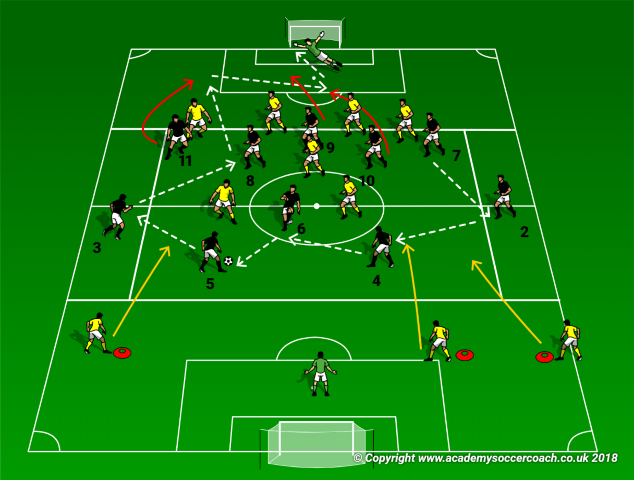
Main Part: Global Situation 3 – 11v11 Match.
Area: Full pitch.
Targeted outcomes: 1, 2, 3, 4, 5 and 6.
Duration: 18 minutes (2 x 8 minutes with two minutes rest in between series).
Play a normal match but review the key outcomes worked on during the previous activity with the players. The key points to remember are to overload the ball zone, have staggered passing angles, and support and cover behind the ball to switch the ball quickly.
Conclusive Part – Cool down.
Duration: 10 minutes.
Player A passes to player C inside the grid who performs a compass movement with player B prior to receiving the ball. Player B passes to player D, and the latter passes to player E who dribbles to the starting position. Perform the next repetition by playing the ball to player F instead of to player E. End the session with static stretching exercises.
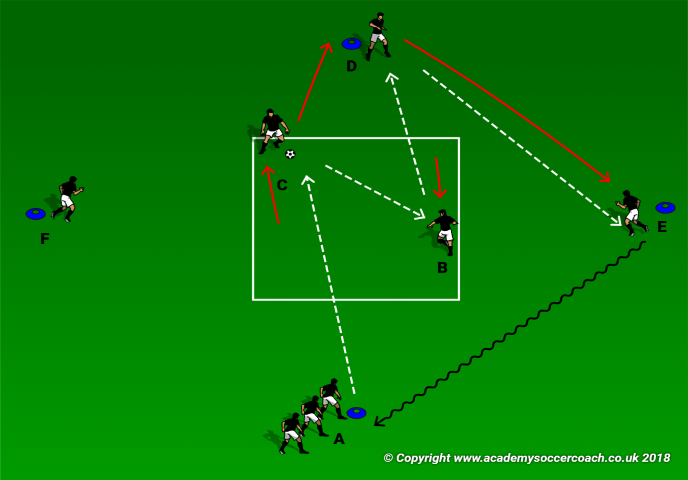
Session 6
Aim: To verticalize play and support the attack.
Outcomes:
1. Length and space created by the striker.
2. Staggered passing options.
3. Support the forward pass.
4. Off-the-ball movement to create space to play behind the defence.
5. Timing of passes and movement to attack the space behind the defence.
6. Support and cover behind the player with the ball to be able to apply immediate pressure in case of a turnover.
Total duration of session: Approximately 90 minutes.
Formation based on: 1-4-3-3.
Complexity level: Inter-sectoral (midfielders and forwards).
Equipment:
Bibs: Eight yellows.
Balls: At least eight to allow for a better session flow.
Markers: Twenty to mark pitch.
Markers: Two yellow and two red to mark starting positions in the analytical exercises.
Description: In this session we work with the midfield and forward sectors in order to create and exploit space when playing against a high line. To be able to accomplish this, we need the striker to create movement and thus options either for him to receive the ball or for the ball to be played to his teammates. Insertions from midfield into the attack are also encouraged. As the striker’s movements create space, the midfielders or inside forwards are required to make the best use of it by attacking the lanes created to receive the ball played behind the opponents’ back line.
Warming Up: Staggered passing angles to play deep.
Area: 20 yards x 30 yards divided into two equal zones.
Targeted outcomes: 2 and 3.
Duration: 20 minutes.
We start the practice with activation exercises and footwork using various tools and mediums such as agility ladder, hoops and very low hurdles. These exercises are interspersed with dynamic flexibility and mobility and take approximately ten minutes to complete.
After the activation part we move on to the exercise described and illustrated below. This exercise prepares the players for the off-the-ball movements required to create staggered angles of support. Focus is on the quality and timing of movements performed by players at positions B and C. The exercise starts by player A who passes to player C after the latter and player B have moved to create staggered passing angles to support each other. Player C lays the ball off the player B to play the ball to Player D1. Player D1 dribbles the ball back to start. After each play, players move one position forward, from position A to position B, from position B to position C, and from position C to position D. Alternate playing the ball to players at positions D1 and D2. We can further progress this exercise by having Player D1 switching play to player D2 and the latter dribbling the ball back to start.
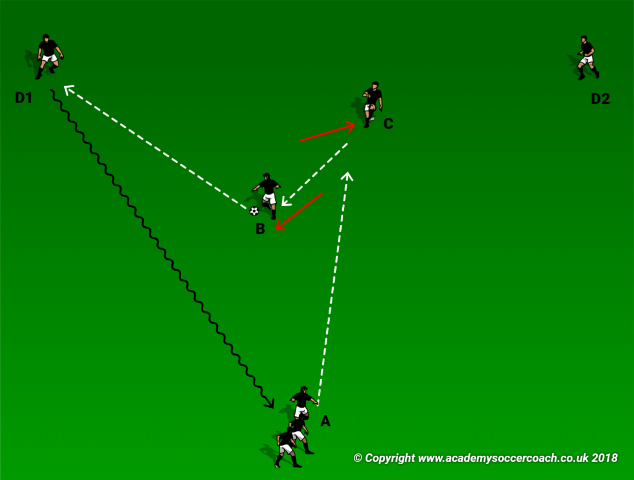
Main Part: Global Situation 1 – 9v9 with a high line.
Area: 40 yards + 25 yards x 40 yards.
Targeted outcomes: 1, 2, 3, 4, 5 and 6.
Duration: 20 minutes (2 x 9 minutes with two minutes rest in between series).
Play starts inside a 40 yard by 40 yard area. We have one team playing in a 1-2-3-3 formation formed by a goalkeeper, two central defenders, three midfielders and three forwards (blacks) against a 1-4-1-2-1 formed by a goalkeeper, back four and four midfielders positioned in a diamond shape. The team with the defenders and midfielders (yellows) defend in front of a pre-assigned offside line. The other team, the one we are coaching, must try to score after playing the ball behind this offside line. Timing of passes and attacking balls played behind this line is crucial for a successful attack. Once the ball is played behind this line, all players can attack or defend. Restarts always take place from the goalkeeper of the attacking team (blacks), therefore recalling the same situation to reoccur several times and thus mould our team’s behaviour in this phase of the game.
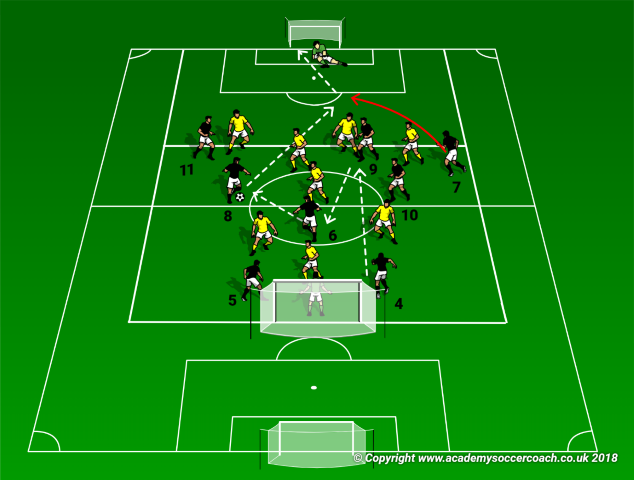
Main Part: Analytical 1 – Attack at speed.
Area: 40 yards x 25 yards.
Targeted outcomes: 1, 2, 3, 4, 5 and 6.
Duration: 10 minutes (2 x 5 minutes with two minutes rest between series).
The attacking team (blacks) aims to score in the upper goal while being pressured by the defenders (yellows) who aim to prevent the attackers from scoring, win the ball and counter in the opposite goal. The situation starts by having two attackers (encircled) moving to off-set each other and create space. The ball is then played from one of the attackers on the outside of the area to one of these two attackers. Situation becomes 4v3 in favour of the attacking team. In this exercise we focus on the off-set movements created by the two forwards before the ball is played. Speed and correct execution of the attack through proper timing of passes and off-the-ball movement is of extremely high importance.
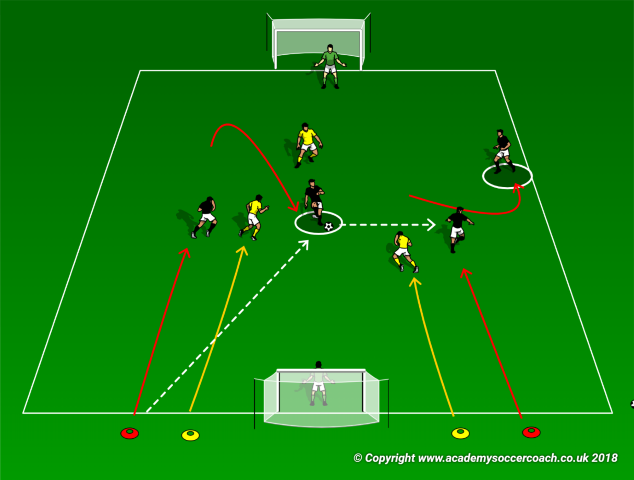
Main Part: Analytical 2 – Attack at speed.
Area: 40 yards x 25 yards.
Targeted outcomes: 1, 2, 3, 4, 5 and 6.
Duration: 10 minutes (2 x 4 minutes with two minutes rest between series).
We progress from Analytical exercise 1 by now assigning the players to their position as in the formation in which the team plays. Now players find themselves in situations that are more realistic and which hold problems that they will typically encounter and have to solve in a match. The situation starts by having attackers 7, 9 and 11 high and wide against two defenders. The ball must be played by attacker 8 to the striker 9. As soon as the ball is passed by attacker 8, attackers 8 and 9 and the other two defenders come into play. The offside rule is in effect. The attacking team must quickly combine between them in order to create scoring opportunities. We pay particular attention to the length being provided by striker 9 and the positioning of the forwards 7 and 11 to remain wide in order to create the required gaps to play through the defence. The exigencies of the situation might require the midfielders to insert themselves in attack or as is the case in the below diagram to have the lateral forward to cut inside to receive a through pass.
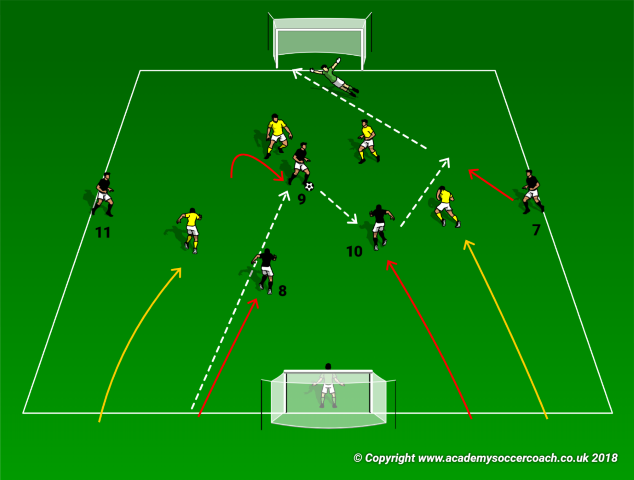
Main Part: Global Situation 2– 9v9 with normal rules.
Area: 65 yards by 50 yards.
Targeted outcomes: 1, 2, 3, 4, 5 and 6.
Duration: 20 minutes (2 x 9 minutes with two minutes rest in between series).
This game takes place on bigger pitch than in the global 1. The reason being that now as we play a normal game with no specific zones and that we have more space, the players should make better use of this space to stretch the opponents to create the vertical gaps needed to verticalize. We pay particular attention to the positioning of the three forwards to give us both height and width, the staggered angles of the midfielders, and stability given by the defenders. Communication between players playing at close proximity with each other should be encouraged, thus giving us a higher chance of penetration. As an example, inside forward 7 goes wide taking the full back with him, striker 9 remains central and midfielder 8 identifies the correct time to insert himself into attack as a result of the space created by the latter two players.
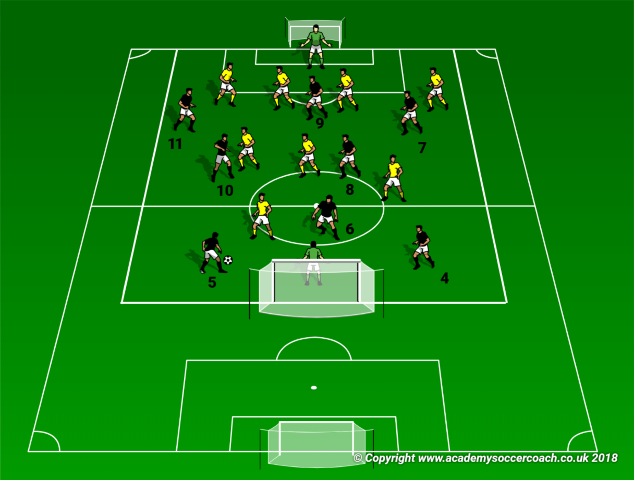
Conclusive Part: Cool down
Duration: 10 minutes.
Player A passes to player B who lays the ball back to player A prior to playing it to player C. Player C wall-passes with player A and dribbles back to start. Alternate passing to positions C1 and C2.
If we feel that the session was highly demanding from a mental point of view, we perform a simple variation of this exercise. In this case player A passes to player B, player B passes to player C, and player C dribbles back to start. After each repetition players move one position forward. Player A moves to position B, player B moves to position C (C1 or C2) while player C dribbles back to positon A.
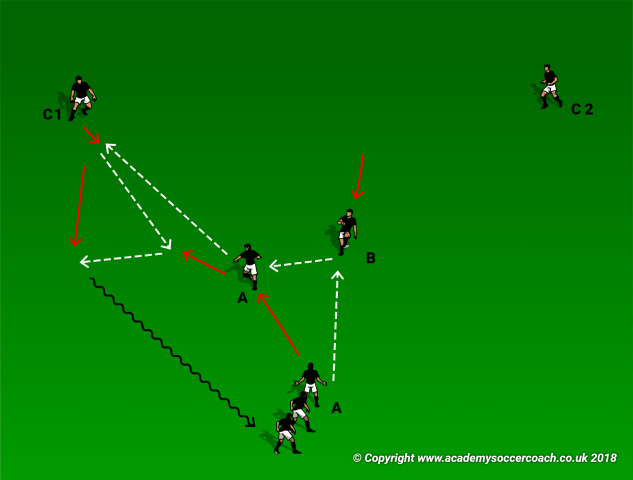
End the training session with static stretching exercises paying particular attention to the quadriceps muscles, hamstrings, glutes, calves and lower back.
Conclusion.
This book analyses the technical and tactical aspects required to play a possession dominant style of play taking Spanish soccer as a main source of reference. In order to dominate play, highly skilled players who are able to read the game at an exceptional level is required. Playing top level soccer, the players must not only be able to react quickly to continuously changing game situations, but must also be able to recognise the right stimuli to anticipate play. Therefore, always being one or two steps ahead of the opponent.
The training activities and sessions presented in this book are targeted to improve correct decision-making and speed of play. Players are thus all the time being stretched cognitively to make the right decisions. In soccer, decision-making, although performed by a single player, combines for a collective team effort. If a player has the ball, another player must make the right movements to get free of marking and receive the ball in space. The ball-carrier must also be able to select the right solution from a number of options, thus increasing the team’s chances of scoring.
This heavily involves team communication, which should therefore be present in all training situations. It is through such training situations that players develop strong relationship links between them. These links refer to the positions that are at close proximity with each other and in which players develop an awareness and an understanding of how they will behave as a group or sector in a particular moment of the game.
About the Author
Philip Joe Cauchi is a UEFA A and a UEFA A Youth Elite qualified soccer coach currently working in Malta. Philip’s area of expertise is in the development of tactical and game intelligence in youth soccer. His experience ranges from coaching eight year olds up to senior team levels. Cauchi is also a qualified soccer conditioning coach, a speed, agility and quickness licence holder and a physical education teacher. Cauchi has has also written many articles for the world renowned soccer website WORLD CLASS COACHING.
References
Allison, S. (2013). Coaching the Barcelona 4-3-3 – attacking. Kansas: World Class Coaching.
Bertolini, L. (2018). 35 possession rondos. Kansas: World Class Coaching.
Bordonau, J.L. & Villanueva, J. (2018). Tactical periodization – a proven successful training model. London: Soccer Tutor.
Casa Basile, P. (2015). Coaching positional play. London: Soccer Tutor.
Davies, J. C. (2013). Coaching the tiki taka style of play. London: Soccer Tutor.
Davies, J. C. (2016). The philosophy of football: In shadows of Marcelo Bielsa. London: Rocketbird.
Fletcher, L. (2018). Tips for coaches when delivering rondo practices. Retrieved October 21st, 2018 from The Coaching Manual. Website: https://www.thecoachingmanual.com/ Contect/6294374885359616
Gutiérrez Mayor, J. E. (2012). Possession: Play football the Spanish way. London: Soccer Tutor.
Grima, S. (2016). Foundations for a football culture (2nd ed.). Malta.
Grima, S. (2017). Effective football coaching sessions: Coaching using the 1-4-3-3 system. Malta.
Mallo, J. (2015). Complex football. Spain: TopProSoccer S.L.
Maurizi, A, (2018). La marcatura preventiva. Il nuovo calcio, 302, 30-33.
Minutillo, D. & Rafloski, R. (2015). A practical guide to tactical periodization. Kansas: World Class Coaching.
Pascual, J. (2013). Coaching Spanish soccer. Kansas: World Class Coaching.
Schreiner, P. & Elgert, N. (2013). Attacking Soccer – Mastering the modern game. Maidenhead: Meyer & Meyer Sport.
Tamboer, J. (2016). Football theory. Amsterdam: World Football Academy.
Van Kolfschooten, F. (2015). How simple can it be? Unique lessons in professional football: behind the scenes with Raymond Verheijen. Amsterdam: World Football Academy.
Verheijen, R. (2014). Football periodisation. Amsterdam: World Football Academy.


